A Day in the Life of EPA Administrator Gina McCarthy - October 2, 2015: Innovation in Atlanta
Administrator McCarthy traveled to Atlanta. Her mission: to highlight innovation and sustainability in American manufacturing, and to meet with young leaders from across the U.S. and the globe who will help to create solutions to our environmental challenges. She also stopped by The Weather Channel's headquarters to talk about EPA's new ozone and worker protection standards, and to stress the important role that science must play as our country decides how to act on climate change.
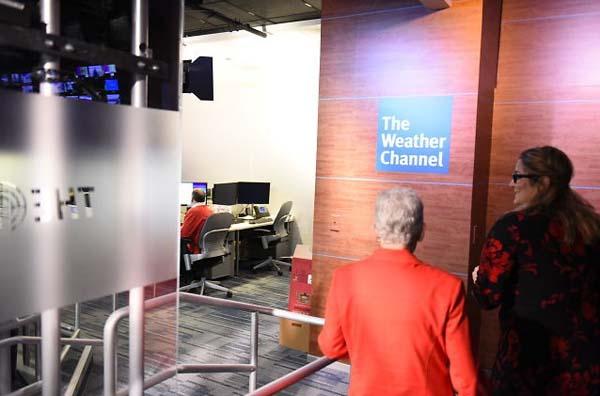 The Administrator started her day at The Weather Channel's offices, where producer Ioanna Dafermou met her for a behind-the-scenes look at the technology and operations the station uses to track and report our nation's weather. (1 of 15)
The Administrator started her day at The Weather Channel's offices, where producer Ioanna Dafermou met her for a behind-the-scenes look at the technology and operations the station uses to track and report our nation's weather. (1 of 15)
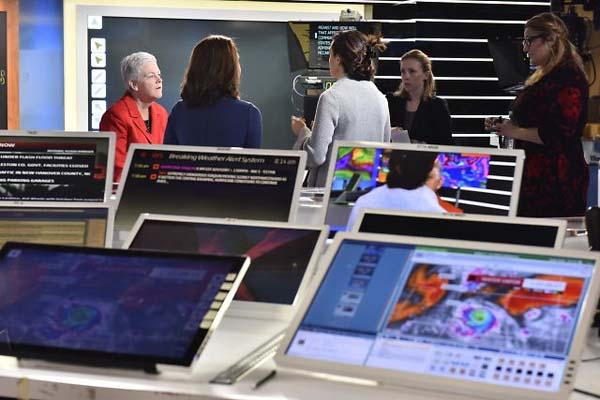 At The Weather Channel's headquarters, hundreds of employees carry out the activities that make weather news happen - from research to preparing data to managing the set to running the channel's website and applications. The Administrator toured the offices to see these functions in action, and talked briefly with staff members. (2 of 15)
At The Weather Channel's headquarters, hundreds of employees carry out the activities that make weather news happen - from research to preparing data to managing the set to running the channel's website and applications. The Administrator toured the offices to see these functions in action, and talked briefly with staff members. (2 of 15) 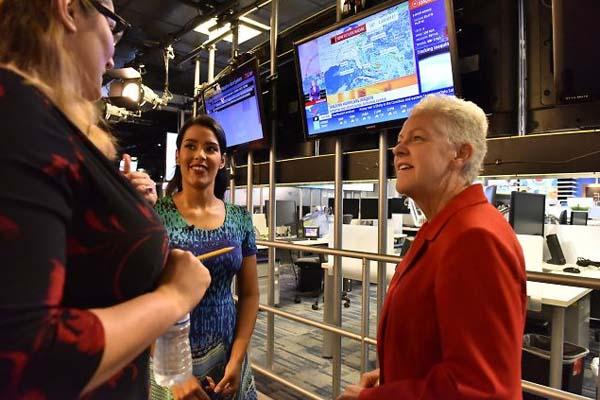 All around The Weather Channel's offices, news and data about the weather appear on big screens. The Administrator chats with staff members while the latest reports about then-upcoming Hurricane Joaquin play in the background. (3 of 15)
All around The Weather Channel's offices, news and data about the weather appear on big screens. The Administrator chats with staff members while the latest reports about then-upcoming Hurricane Joaquin play in the background. (3 of 15)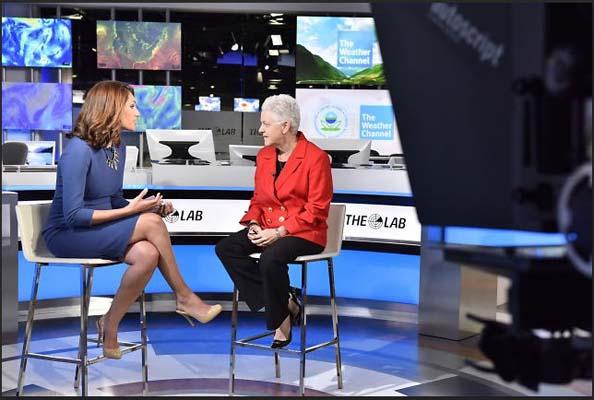 Administrator McCarthy sat down with anchor Maria LaRosa for a conversation about how climate change can intensify storms like Hurricane Joaquin, and how climate science is showing us that we are seeing the impacts of climate change here and now. They also chatted about EPA's new rules to limit ground-level ozone (or smog), and to better protect farmworkers from pesticide over-exposure. (4 of 15)
Administrator McCarthy sat down with anchor Maria LaRosa for a conversation about how climate change can intensify storms like Hurricane Joaquin, and how climate science is showing us that we are seeing the impacts of climate change here and now. They also chatted about EPA's new rules to limit ground-level ozone (or smog), and to better protect farmworkers from pesticide over-exposure. (4 of 15) 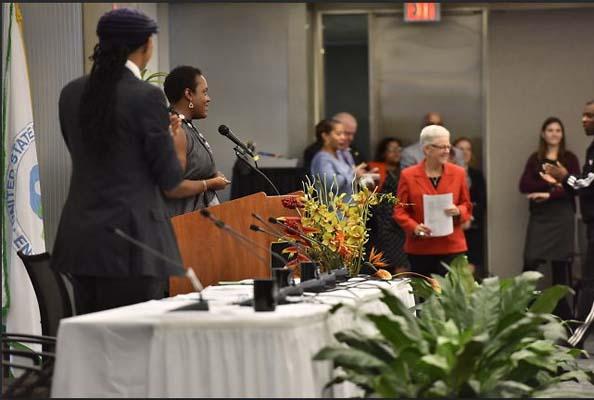 Administrator McCarthy then traveled to the Sam Nunn Atlanta Federal Center, where young people from across the nation and the globe gathered for the International Youth Symposium to talk about the importance of global climate action. She gave a few remarks before meeting the attendees. (5 of 15)
Administrator McCarthy then traveled to the Sam Nunn Atlanta Federal Center, where young people from across the nation and the globe gathered for the International Youth Symposium to talk about the importance of global climate action. She gave a few remarks before meeting the attendees. (5 of 15)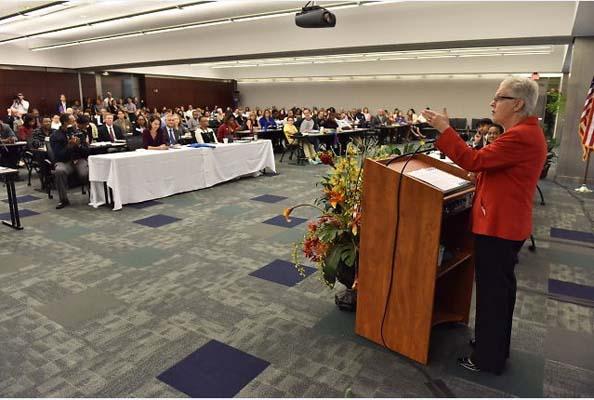 Every available seat was taken, and some attendees stood up in the back to listen. She encouraged them all to consider careers in public service, noting that "young people like you have always been the drivers of the environmental revolution. And we need you today more than ever. So stay engaged on environmental issues, especially climate change - we need creative, passionate people like you to come up with solutions to protect our planet for future generations." (6 of 15)
Every available seat was taken, and some attendees stood up in the back to listen. She encouraged them all to consider careers in public service, noting that "young people like you have always been the drivers of the environmental revolution. And we need you today more than ever. So stay engaged on environmental issues, especially climate change - we need creative, passionate people like you to come up with solutions to protect our planet for future generations." (6 of 15)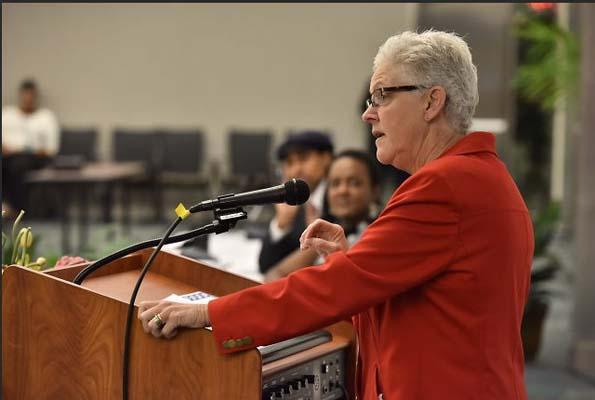 Administrator McCarthy also talked about EPA's Clean Power Plan and its role in driving the growth of renewable energy, and she encouraged the young people to continue raising their voices for environmental justice and healthier communities. (7 of 15)
Administrator McCarthy also talked about EPA's Clean Power Plan and its role in driving the growth of renewable energy, and she encouraged the young people to continue raising their voices for environmental justice and healthier communities. (7 of 15)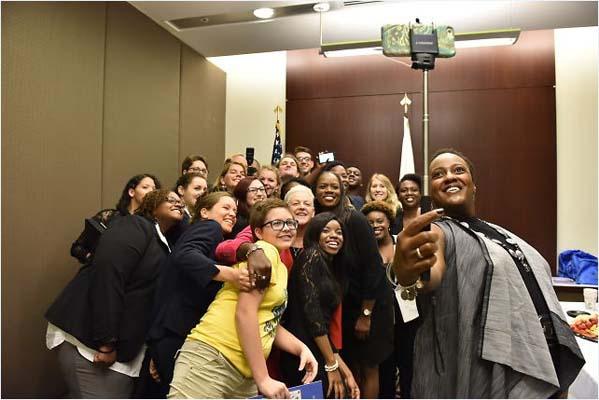 After concluding her remarks, the Administrator chatted briefly with some of the young environmental advocates in attendance, and she found a few seconds to take a selfie. (8 of 15)
After concluding her remarks, the Administrator chatted briefly with some of the young environmental advocates in attendance, and she found a few seconds to take a selfie. (8 of 15) Administrator McCarthy traveled from the symposium to a Manufacturing Day 2015 event hosted by Georgia Tech's Manufacturing Extension Partnership. She was treated to a special tour of the Georgia Tech Manufacturing Institute and got to explore cutting-edge techniques that can make our country more sustainable while driving our economy forward. (9 of 15)
Administrator McCarthy traveled from the symposium to a Manufacturing Day 2015 event hosted by Georgia Tech's Manufacturing Extension Partnership. She was treated to a special tour of the Georgia Tech Manufacturing Institute and got to explore cutting-edge techniques that can make our country more sustainable while driving our economy forward. (9 of 15)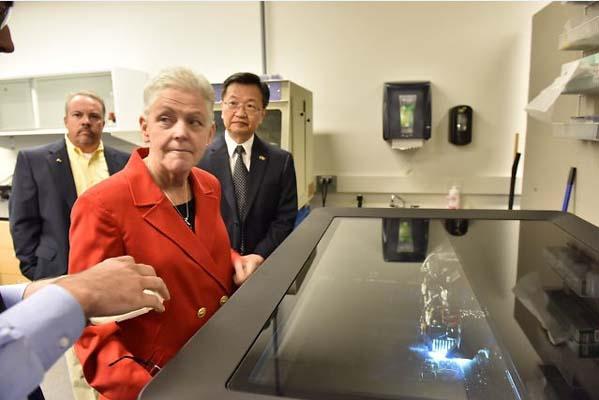 3D printing is a new technology that holds promise for advancing American manufacturing. It can be used to rapidly create prototypes and parts that are difficult - or in some cases, impossible - to manufacture through conventional methods. 3D printing can reduce material waste, and it can help us to design lighter aerospace or car parts that can help save fuel, energy, and money. Dr. Ben Wang, right, executive director of GTMI, and his graduate students demonstrated the process to Administrator McCarthy. (10 of 15)
3D printing is a new technology that holds promise for advancing American manufacturing. It can be used to rapidly create prototypes and parts that are difficult - or in some cases, impossible - to manufacture through conventional methods. 3D printing can reduce material waste, and it can help us to design lighter aerospace or car parts that can help save fuel, energy, and money. Dr. Ben Wang, right, executive director of GTMI, and his graduate students demonstrated the process to Administrator McCarthy. (10 of 15)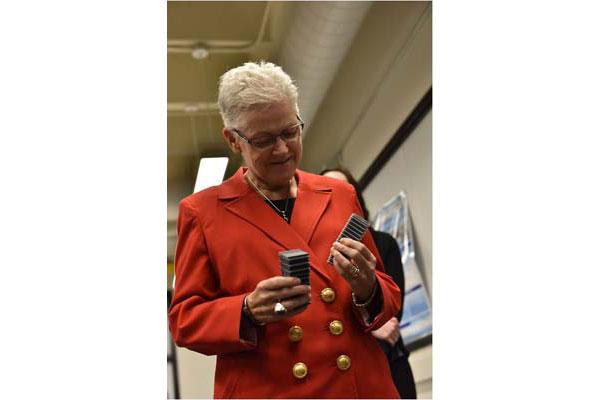 The Administrator examined some 3D printed parts that are auxetic, which means that they get larger when pulled and smaller when compressed. This allows the parts to be custom tailored by designers to fit their projects. These auxetic parts are lighter in weight than conventional parts, and the process of creating them generates less waste than conventional manufacturing. (11 of 15)
The Administrator examined some 3D printed parts that are auxetic, which means that they get larger when pulled and smaller when compressed. This allows the parts to be custom tailored by designers to fit their projects. These auxetic parts are lighter in weight than conventional parts, and the process of creating them generates less waste than conventional manufacturing. (11 of 15)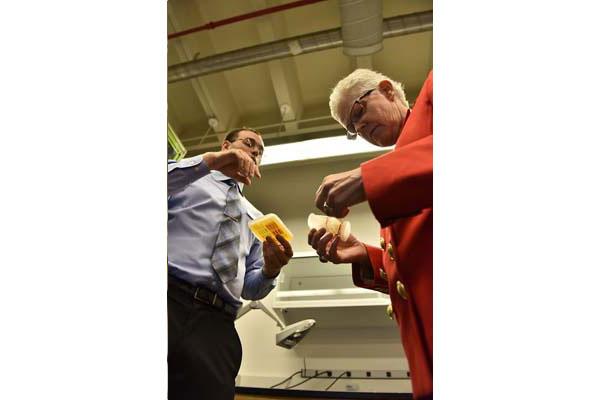 Administrator McCarthy also took a close look at a special device that mimics human heart valves to help doctors plan for successful surgeries. Chris Oberste, a Georgia Tech graduate student, explains that the device contains a special sensor that was placed there through aerosol jet printing, a new type of printing that can be used to create circuits, sensors, antennas and other electrical components. Unlike conventional methods, aerosol jet printing produces almost no waste, and it does not use hazardous chemicals that can put the environment and people's health at risk. For small scale production, it's also more cost-effective. (12 of 15)
Administrator McCarthy also took a close look at a special device that mimics human heart valves to help doctors plan for successful surgeries. Chris Oberste, a Georgia Tech graduate student, explains that the device contains a special sensor that was placed there through aerosol jet printing, a new type of printing that can be used to create circuits, sensors, antennas and other electrical components. Unlike conventional methods, aerosol jet printing produces almost no waste, and it does not use hazardous chemicals that can put the environment and people's health at risk. For small scale production, it's also more cost-effective. (12 of 15)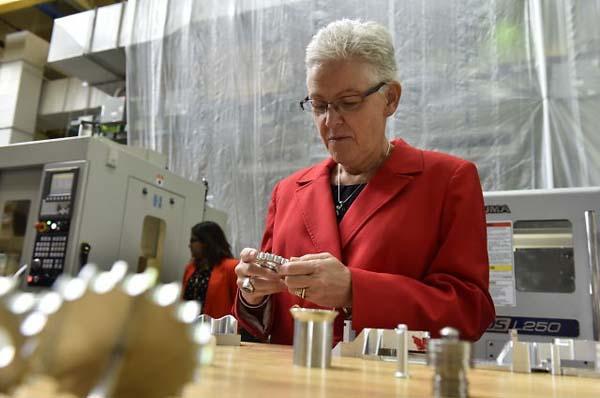 The Administrator checked out some components produced by the Prototyping Service Center at the Georgia Tech Manufacturing Institute (GTMI). GTMI works with manufacturing startups to create prototypes and develop processes. GTMI also helps these startups explore cutting-edge manufacturing techniques and find their way through challenges they face. (13 of 15)
The Administrator checked out some components produced by the Prototyping Service Center at the Georgia Tech Manufacturing Institute (GTMI). GTMI works with manufacturing startups to create prototypes and develop processes. GTMI also helps these startups explore cutting-edge manufacturing techniques and find their way through challenges they face. (13 of 15)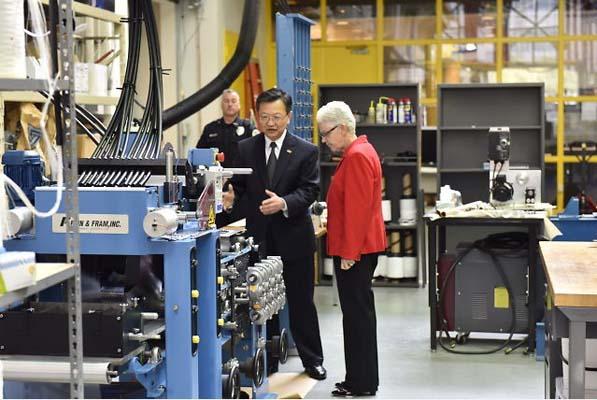 Cars can perform better, be safer, and use less fuel when they're made with materials created by this sheet molding compounding line. It manufactures polymer composites, or blended materials made from plastics and other compounds, that are lightweight and strong. Dr. Ben Wang, GTMI executive director, explains to the Administrator how the line recycles carbon fiber scraps to create the composites, reducing waste and cutting down on the need for new raw materials. (14 of 15)
Cars can perform better, be safer, and use less fuel when they're made with materials created by this sheet molding compounding line. It manufactures polymer composites, or blended materials made from plastics and other compounds, that are lightweight and strong. Dr. Ben Wang, GTMI executive director, explains to the Administrator how the line recycles carbon fiber scraps to create the composites, reducing waste and cutting down on the need for new raw materials. (14 of 15)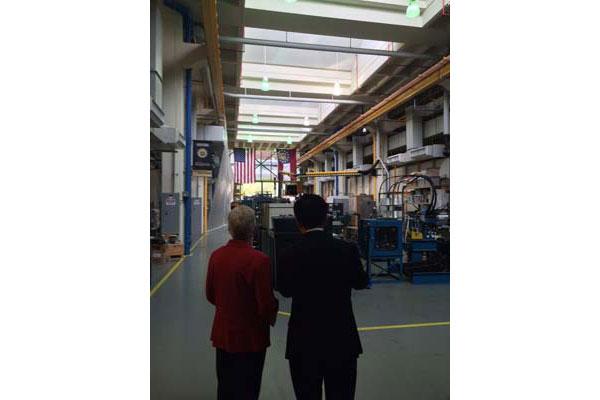 Protecting the environment is central to a growing economy. These new technologies help our country reduce fuel use and act on climate at the same that they help the manufacturing sector to grow stronger. The Administrator takes a last look around with Georgia Tech Manufacturing Institute Executive Director Dr. Ben Wang, who provided the tour. (15 of 15)
Protecting the environment is central to a growing economy. These new technologies help our country reduce fuel use and act on climate at the same that they help the manufacturing sector to grow stronger. The Administrator takes a last look around with Georgia Tech Manufacturing Institute Executive Director Dr. Ben Wang, who provided the tour. (15 of 15)